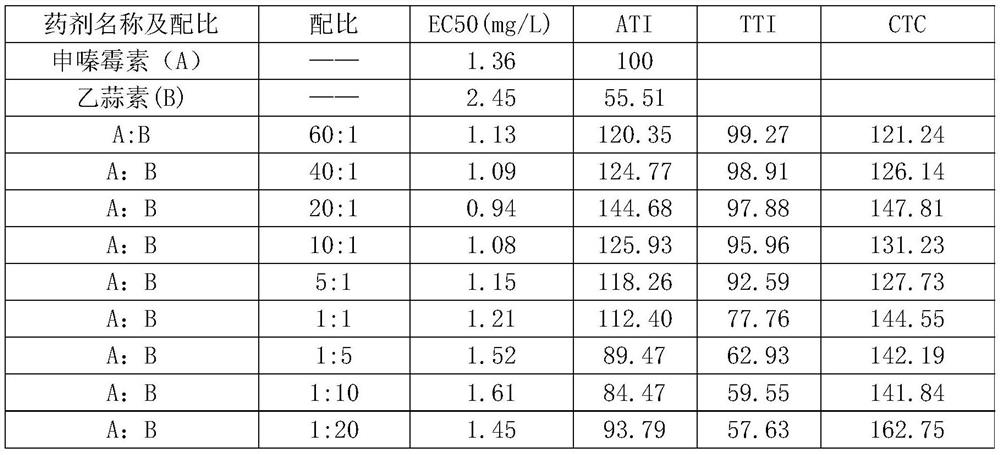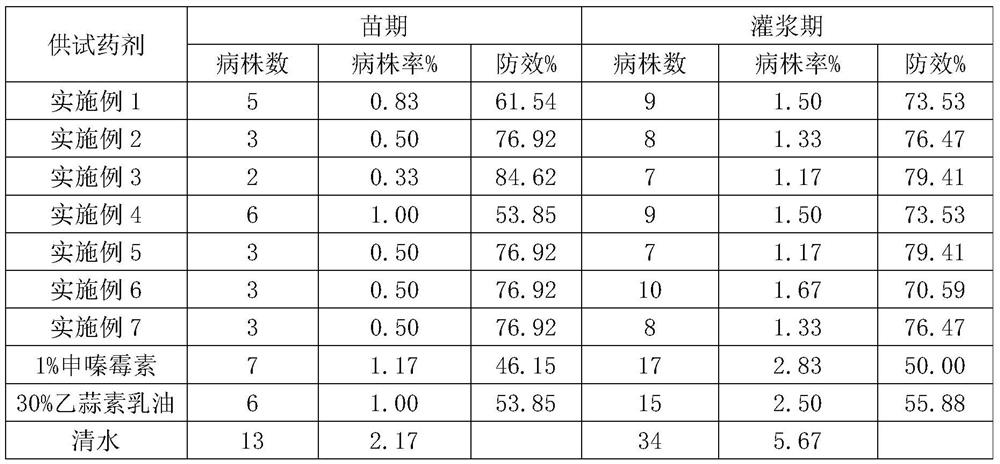Sterilization composition containing phenazino-1-carboxylic acid and ethylicin and application thereof
A kind of technology of styrazinomycin and acetoin, which is applied in the field of pesticides to achieve the effects of delaying resistance, reducing use and reducing use cost
- Summary
- Abstract
- Description
- Claims
- Application Information
AI Technical Summary
Problems solved by technology
Method used
Image
Examples
Embodiment 1
[0019] Bioassay Example 1: Indoor virulence assay of styrazinomycin and ethalicin against rice false smut.
[0020] First, after analyzing the action characteristics of styazinamycin and acetoallicin, it was determined that the bioassay object was Ustilaginoidea oryzae, the pathogen of rice false smut, which belongs to the subphylum Deuteromycota.
[0021] Indoor bioassay test method: refer to "NYT1156.2-2006 Pesticide Indoor Bioassay Test Guidelines Fungicide Part 2: Inhibition of Pathogenic Fungal Mycelium Growth Test Plate Method".
[0022] The growth rate assay was used to determine the inhibitory effect of chemical agents on the growth of rice false smut mycelium. On the basis of the pre-experiment, four concentration gradients were involved in the range of 10% to 90% of the growth inhibition rate of each agent on the mycelial growth of Chlorella oryzae. Dissolve with NN-dimethylformamide as solvent, dilute with 0.1% Tween 80 aqueous solution to obtain a series of gradie...
example 2
[0035] Bioassay Example 2: Indoor virulence assay of styrazinomycin and ethalicin against rice blast.
[0036] Firstly, after analyzing the action characteristics of sentazinemycin and acetocin, it was determined that the pathogen of rice blast was Pyricularia oryzae Cav., which belongs to the genus Pyricularia.
[0037] Indoor bioassay test method: refer to "NYT1156.2-2006 Pesticide Indoor Bioassay Test Guidelines Fungicide Part 2: Inhibition of Pathogenic Fungal Mycelium Growth Test Plate Method".
[0038] The growth rate assay was used to determine the inhibitory effect of the chemicals on the growth of rice blast mycelium. On the basis of the pre-experiment, four concentration gradients were involved in the range of 10% to 90% inhibition rate for the growth of Chlorella oryzae mycelium. Dissolve with NN-dimethylformamide as solvent, and dilute with 0.1% Tween 80 aqueous solution to obtain a series of gradient concentration medicinal solutions for later use. Add the medic...
example 3
[0050] Bioassay Example 3: Indoor virulence assays of styrazinemycin and etiocin against Fusarium wilt of strawberry.
[0051] First, after analyzing the action characteristics of sentazinemycin and acetoallicin, it is determined that the pathogen of strawberry fusarium wilt is Fusarium oxysporum Schl.f.sp.fragariae WinksetWillams. Subphylum fungi.
[0052] Indoor bioassay test method: refer to "NYT1156.2-2006 Pesticide Indoor Bioassay Test Guidelines Fungicide Part 2: Inhibition of Pathogenic Fungal Mycelium Growth Test Plate Method".
[0053] The growth rate assay was used to determine the inhibitory effect of the chemicals on the growth of rice blast mycelium. On the basis of the pre-experiment, four concentration gradients were involved in the range of 10% to 90% of the growth inhibition rate of each agent on the mycelial growth of Chlorella oryzae. Dissolve with NN-dimethylformamide as solvent, dilute with 0.1% Tween 80 aqueous solution to obtain a series of gradient co...
PUM
 Login to View More
Login to View More Abstract
Description
Claims
Application Information
 Login to View More
Login to View More - R&D
- Intellectual Property
- Life Sciences
- Materials
- Tech Scout
- Unparalleled Data Quality
- Higher Quality Content
- 60% Fewer Hallucinations
Browse by: Latest US Patents, China's latest patents, Technical Efficacy Thesaurus, Application Domain, Technology Topic, Popular Technical Reports.
© 2025 PatSnap. All rights reserved.Legal|Privacy policy|Modern Slavery Act Transparency Statement|Sitemap|About US| Contact US: help@patsnap.com



